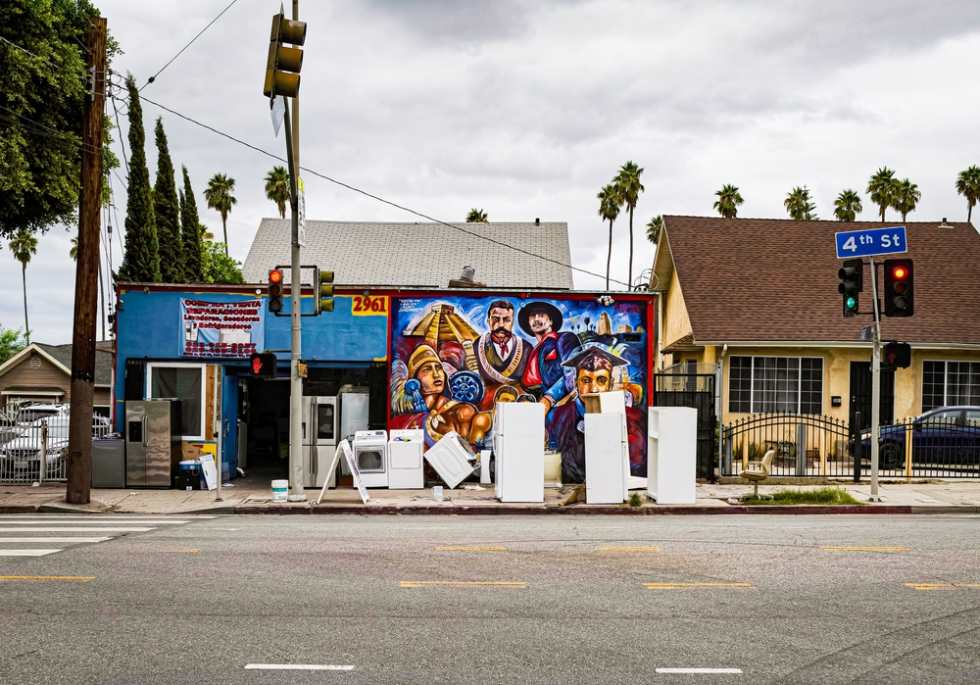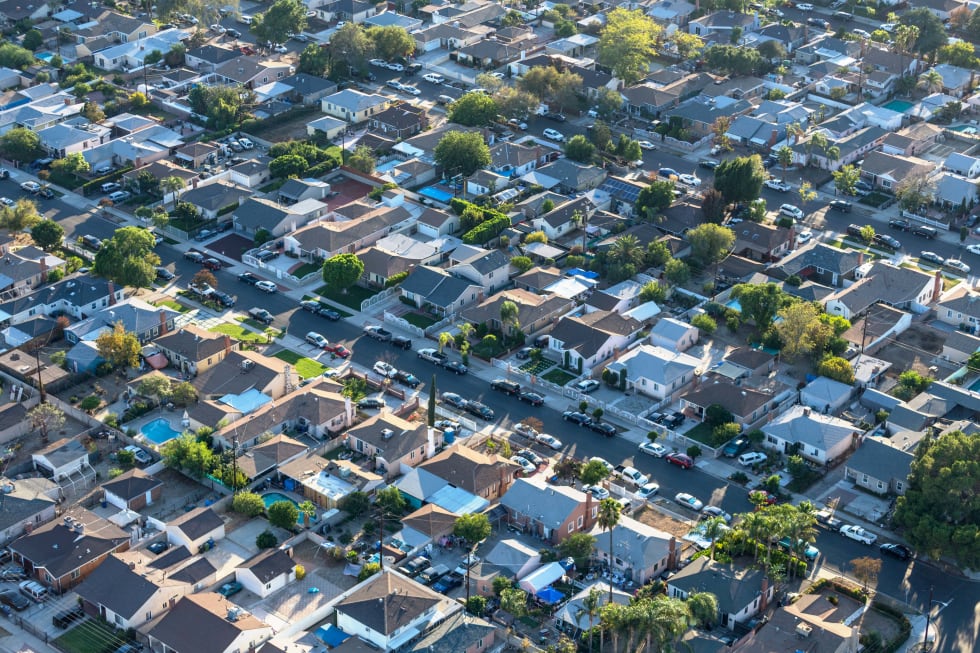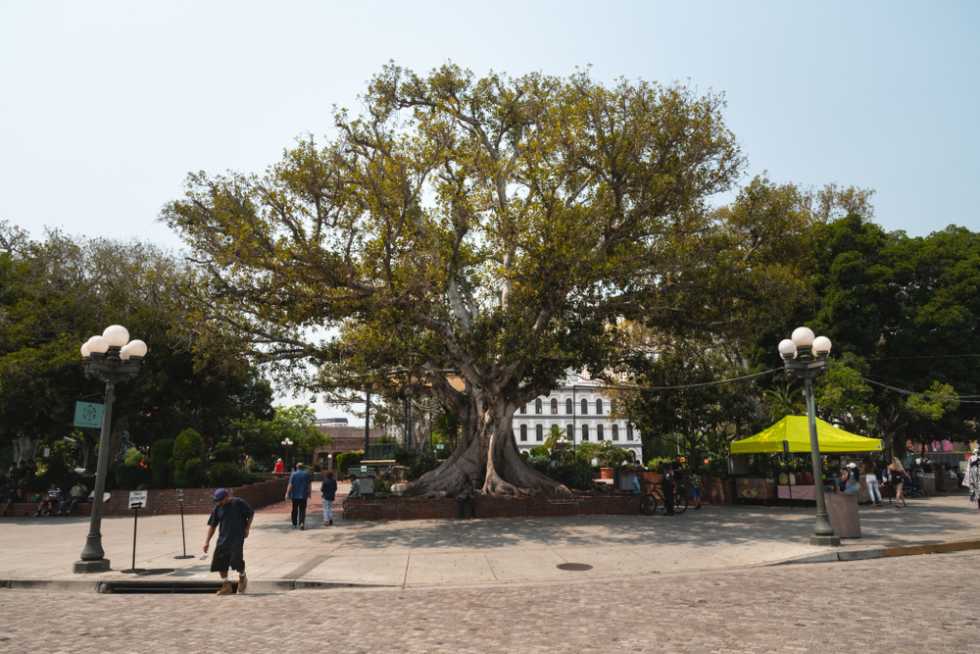Modera Argyle
- 66 units available
- 1 bed • 2 bed • 3 bed
- Amenities
In unit laundry, Patio / balcony, Granite counters, Hardwood floors, Pet friendly, 24hr maintenance + more

Los Angeles rents are among the highest in the nation, but that doesn’t mean you have to blow your budget to live here. From artsy enclaves to commuter-friendly suburbs, there are still pockets of affordability if you know where to look. The neighborhoods featured in this guide average around $1,790 for a one-bedroom, which is roughly $728 less than the 2025 citywide average of $2,518.
In this guide, we break down the 12 cheapest neighborhoods in Los Angeles for renters in 2025, using the latest rent data to help you find a place that fits your lifestyle and your wallet. Whether you’re a student, a remote worker, or just trying to cut costs, these neighborhoods offer the best bang for your buck without sacrificing location or livability.
Affordability has become a necessity for renters across Los Angeles in 2025. With the average rent for a one-bedroom hovering above $2,500, and two-bedroom units pushing past $3,800, many Angelenos are feeling squeezed. At the same time, wages have remained mostly flat, and everyday costs, like groceries, gas, and utilities, continue to climb.
That’s why affordable neighborhoods in Los Angeles are drawing more attention than ever. For many renters, it’s no longer about luxury amenities or trendy zip codes, but rather, staying within budget without sacrificing safety, convenience, or quality of life.
Finding cheap rent in LA has become mission-critical for people from all walks of life. In a city where even parking can break the bank, choosing the right neighborhood can mean the difference between living comfortably or barely scraping by.
Los Angeles continues to rank among the most expensive rental markets in the U.S. In 2025, the average rent for a 1-bedroom apartment in L.A. reached $2,513, a steep 43% above the national median of $1,762. While rent growth has cooled slightly, there’s still a growing urgency for budget-conscious renters to seek out more affordable pockets of the city.
| Year | Los Angeles Average (1BR) | US Average (1BR) | % Difference |
|---|---|---|---|
| 2024 | $2,962 | $1,787 | +67.71% |
| 2025 | $2,513 | $1,762 | +43.00% |
Several economic and lifestyle shifts are driving L.A. renters to explore cheaper neighborhoods in 2025:
To help renters find real value without sacrificing quality of life, we built this list using a combination of proprietary Apartment List rental data and verified third-party sources. Our primary focus was on 1-bedroom median rents across Los Angeles neighborhoods, drawn from listings posted between Q1 and Q2 of 2025.
We cross-referenced data from Apartment List, Rent.com, the U.S. Census American Community Survey (ACS), and the California Association of Realtors (C.A.R.) to ensure accuracy.
We then calculated the average rent for each neighborhood. To maintain fairness and clarity, we excluded outliers, which we define as rent prices more than 1.5 interquartile ranges above or below the median. This prevents unusually high-end or distressed listings from skewing results.
Our final dataset reflects price trends that everyday renters are most likely to encounter.
To qualify for this list, each neighborhood also had to meet a strict set of livability standards:
Here are three key stats from our filtered group:
From the Eastside to the Valley to South LA, these twelve neighborhoods prove that affordability in Los Angeles comes in all shapes, sizes, and zip codes.
Boyle Heights is just across the river from Downtown L.A., making it a solid pick for renters who want quick access to city life without paying downtown prices. The area is full of taquerias, community murals, and family-owned markets that give it a lived-in, local feel.
Mariachi Plaza and Evergreen Cemetery are landmarks, and the Gold Line station keeps public transit options within reach. While the walkability is decent, parking can be tough on narrow streets.
Renters often appreciate the neighborhood’s mix of older buildings with character and newer units with better amenities. Commute-wise, it’s well-positioned for access to the 5, 10, and 60 freeways, but traffic can be slow during peak hours.
Find your ideal rental in Boyle Heights today

Tucked in the San Fernando Valley, Panorama City appeals to renters looking for space and value. It’s one of the more affordable areas in the Valley, especially for two-bedroom units.
Nearby Sepulveda Recreation Center has sports fields, picnic spots, and a pool. The 405 and 170 freeways run close by, so you can reach Downtown L.A. or West L.A. in about 35–50 minutes, traffic depending. Bus routes are available but limited in frequency.
Shopping is easy with local plazas and the Panorama Mall. You’ll also find a mix of longtime residents and working professionals here. It’s quieter than more central parts of the city, but that’s part of the draw for many renters.
Find your ideal rental in Panorama City today
Arleta has a quiet, residential atmosphere with wide streets and mostly single-family homes. While it doesn’t have a ton of nightlife or shopping options on its own, major retail corridors in Pacoima and Panorama City are nearby.
It’s a car-dependent neighborhood, though the 5 and 170 freeways help make commuting easier if you’re heading into Burbank, Glendale, or Downtown. Public transit is limited, so plan on driving to most places.
Local parks like Branford Park give families and dog owners a place to stretch out. Renters are usually drawn by the lower costs and the chance to find units with more space or private yards.
Find your ideal rental in Arleta today
Van Nuys is one of the central neighborhoods in the Valley and comes with strong transit options, including a Metrolink station and multiple bus lines. It’s busy, with plenty of strip malls, auto shops, and taco stands, but also has quiet pockets of apartments and older homes.
The government center includes the courthouse and police station, making it a high-traffic area during work hours. Commute times to downtown are long but manageable by freeway. Renters can expect a wide range of unit styles and prices. Sherman Way offers a lot of food options, while Lake Balboa Park is just a short drive away for outdoor space.
Find your ideal rental in Van Nuys today

Greater Valley Glen sits between Van Nuys and North Hollywood and is mainly residential, with small apartment complexes and mid-century homes. It’s known for being quieter than the surrounding neighborhoods but still relatively close to North Hollywood’s entertainment and arts scenes.
Commuters use the 170 Freeway or nearby Metro Red Line stations for access to central L.A. Local highlights include the Great Wall of Los Angeles mural and Valley Glen Community Park. Renters often look here for budget-friendly options without moving too far from busier parts of the Valley. Street parking is usually available, and the area has a laid-back rhythm with fewer crowds.
Find your ideal rental in Greater Valley Glen today
Congress North is a compact area just west of Downtown Los Angeles. It features a range of housing options from older duplexes to low-rise apartment buildings. Residents enjoy being near the Expo Line, which provides reliable public transit to USC, Culver City, and Santa Monica.
The neighborhood also borders West Adams and Jefferson Park, putting you close to grocery stores, cafes, and city services. Walkability is strong, though parking can be a challenge. While the area is still developing, renters like the relative affordability and easy access to work and school zones. Safety varies block by block, so many prospective renters do a few neighborhood visits before committing.
Find your ideal rental in Congress North today
Pico Union is one of the city’s oldest neighborhoods and remains a price-conscious option for renters who want to be near downtown without the steep cost. Compact streets are packed with small restaurants, pupuserias, discount stores, and churches.
You’ll find mostly apartment buildings here, with occasional single-family homes converted into multi-unit rentals. The area is served by several Metro lines and is walkable for day-to-day errands. While housing is more affordable, buildings tend to be older, and parking is often limited. Still, it’s hard to beat the location and access to jobs in downtown LA or the Westlake area.
Find your ideal rental in Pico Union today

Mid City stretches across several blocks of central Los Angeles and provides relatively easy access to both the Westside and downtown via major streets like Venice and Pico Boulevards. Renters will find an assortment of mid-rise apartments, small homes, and fourplexes.
Commute times vary depending on traffic, but there’s decent bus coverage and bike routes on quieter streets. Nearby destinations include the Little Ethiopia dining corridor and local museums on Wilshire. Some areas are denser than others, and construction noise or congestion can be a drawback. Still, Mid City makes sense for renters who want a balance of price, access, and options.
Find your ideal rental in Mid City today
Chatsworth sits on the northwest edge of the Valley, where space is more plentiful and rent is typically lower than in coastal neighborhoods. Expect larger units, parking, and some newer complexes near Topanga Canyon Boulevard. The area is less walkable but has reliable access to the Metrolink and several local bus lines.
Outdoor options include Stoney Point Park and regional hiking trails nearby. The tradeoff is a longer drive to central LA, as commutes to downtown can stretch past an hour during rush hour. But if your priority is peace and lower rent, Chatsworth fits the bill.
Find your ideal rental in Chatsworth today
Granada Hills has a more residential setup with suburban features like tree-lined streets, single-family homes, and schools with decent reputations. Grocery stores and casual restaurants are easily reachable by car, but the area isn’t known for public transit.
The lack of density means more space and less noise, which appeals to those seeking a quiet place to live. There’s also quick freeway access via the 118 and 405 for commuters. While it doesn’t offer a lot of nightlife or attractions, Granada Hills works well for renters who prioritize comfort, stability, and a slower pace.
Find your ideal rental in Granada Hills today

Pacoima is a family-focused part of the northeast Valley with a lot of long-term residents and more affordable rent than other areas. The neighborhood includes several public parks, local schools, and modest retail centers.
Commuters often use the 5 or 118 freeways, though traffic can be heavy during peak hours. You won’t find a huge nightlife scene, but the area’s cultural roots and community events offer plenty of local flavor. Renters should keep in mind that housing stock can be older and that public transit access is limited compared to more central neighborhoods.
Find your ideal rental in Pacoima today
Sunland-Tujunga lies near the Angeles National Forest and tends to draw renters who prefer a quieter pace and less density. Housing includes older apartments, cottages, and small homes, and the lower rent reflects the longer distance from central LA.
Public transit options are limited, so most residents rely on cars. That said, the tradeoff is access to trails, mountains, and wide streets with less congestion. There are a handful of small markets, cafés, and businesses throughout the area. It may not work for those needing to commute daily to downtown, but it's a good fit for remote workers or people who value privacy.
Find your ideal rental in Sunland-Tujunga today
These tactics can shave hundreds, sometimes thousands, off your annual rent in one of the country’s most competitive markets.
Start by narrowing your search with a purpose. On Apartment List, set clear budget caps, commute preferences, pet allowances, and must-have amenities to instantly weed out units that don’t fit.
Use map-based filters to pinpoint cheaper pockets just outside hot zones, and always enable instant alerts so you’re the first to know when a deal hits the market. In a city like LA, minutes matter.
Timing your tour can give you leverage. November through January typically sees about 10% fewer applicants, and landlords are more open to offering concessions like a free month or waived fees. It’s usually the best time to look for an apartment.
Aim for mid-morning showings, as natural light will be at its best, and it’s easier to gauge parking availability and neighborhood noise before the rush kicks in.
Always ask: “Is this unit rent-controlled?” If it is, you’re protected under LA’s 4% annual increase cap (as of 2025), which can give you more long-term stability. Showing that you understand rent control rules signals to landlords that you’re informed, and makes you a harder candidate to overcharge. You can also offer to sign a longer lease in exchange for introductory rent discounts or move-in bonuses.
Neighborhoods like Pico-Union, Congress North, and Van Nuys offer budget-friendly rents and direct access to Metro Rail or Rapid Bus lines, making car-free living more realistic in LA.
Most lower-cost rentals in LA—especially those built before October 1978, are covered by the city's rent stabilization ordinance, which limits annual rent increases to 4% as of 2025.
Start your search 30-45 days before your target move-in date. In competitive markets like LA, most listings go live 2-4 weeks before they're available.
Not always. While some units may include water or trash, electricity, gas, and parking often cost extra, especially in older or privately managed buildings.
Pet-friendly options exist, but they’re limited and often come with added pet rent or deposits. Use filters on Apartment List to surface listings that welcome cats, dogs, or both.

In unit laundry, Patio / balcony, Granite counters, Hardwood floors, Pet friendly, 24hr maintenance + more
In unit laundry, Patio / balcony, Dishwasher, Pet friendly, Parking, Stainless steel + more